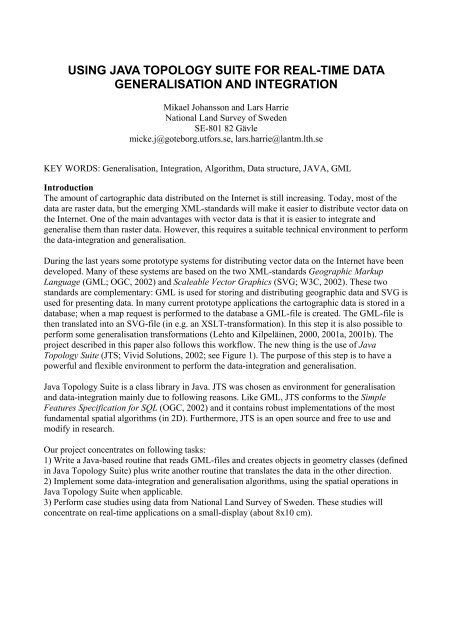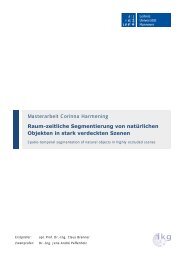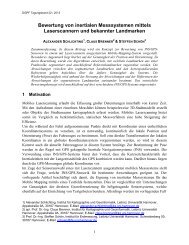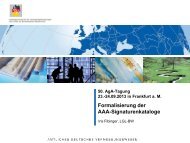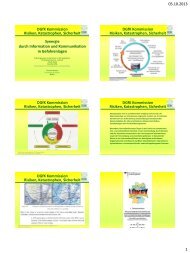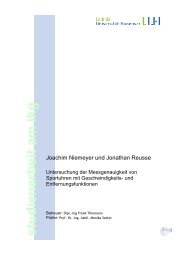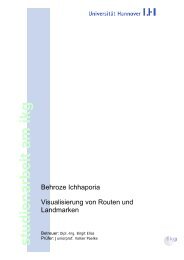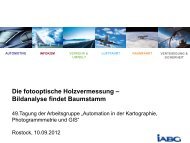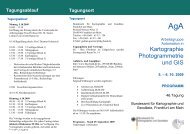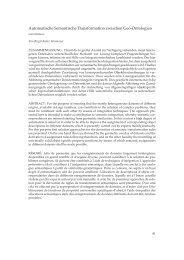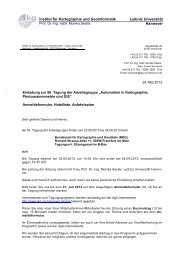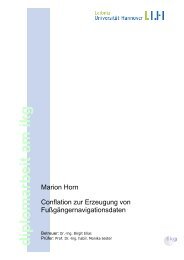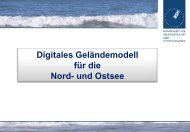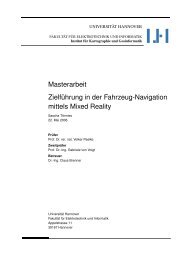USING JAVA TOPOLOGY SUITE FOR REAL-TIME DATA ...
USING JAVA TOPOLOGY SUITE FOR REAL-TIME DATA ...
USING JAVA TOPOLOGY SUITE FOR REAL-TIME DATA ...
Create successful ePaper yourself
Turn your PDF publications into a flip-book with our unique Google optimized e-Paper software.
<strong>USING</strong> <strong>JAVA</strong> <strong>TOPOLOGY</strong> <strong>SUITE</strong> <strong>FOR</strong> <strong>REAL</strong>-<strong>TIME</strong> <strong>DATA</strong><br />
GENERALISATION AND INTEGRATION<br />
Mikael Johansson and Lars Harrie<br />
National Land Survey of Sweden<br />
SE-801 82 Gävle<br />
micke.j@goteborg.utfors.se, lars.harrie@lantm.lth.se<br />
KEY WORDS: Generalisation, Integration, Algorithm, Data structure, <strong>JAVA</strong>, GML<br />
Introduction<br />
The amount of cartographic data distributed on the Internet is still increasing. Today, most of the<br />
data are raster data, but the emerging XML-standards will make it easier to distribute vector data on<br />
the Internet. One of the main advantages with vector data is that it is easier to integrate and<br />
generalise them than raster data. However, this requires a suitable technical environment to perform<br />
the data-integration and generalisation.<br />
During the last years some prototype systems for distributing vector data on the Internet have been<br />
developed. Many of these systems are based on the two XML-standards Geographic Markup<br />
Language (GML; OGC, 2002) and Scaleable Vector Graphics (SVG; W3C, 2002). These two<br />
standards are complementary: GML is used for storing and distributing geographic data and SVG is<br />
used for presenting data. In many current prototype applications the cartographic data is stored in a<br />
database; when a map request is performed to the database a GML-file is created. The GML-file is<br />
then translated into an SVG-file (in e.g. an XSLT-transformation). In this step it is also possible to<br />
perform some generalisation transformations (Lehto and Kilpeläinen, 2000, 2001a, 2001b). The<br />
project described in this paper also follows this workflow. The new thing is the use of Java<br />
Topology Suite (JTS; Vivid Solutions, 2002; see Figure 1). The purpose of this step is to have a<br />
powerful and flexible environment to perform the data-integration and generalisation.<br />
Java Topology Suite is a class library in Java. JTS was chosen as environment for generalisation<br />
and data-integration mainly due to following reasons. Like GML, JTS conforms to the Simple<br />
Features Specification for SQL (OGC, 2002) and it contains robust implementations of the most<br />
fundamental spatial algorithms (in 2D). Furthermore, JTS is an open source and free to use and<br />
modify in research.<br />
Our project concentrates on following tasks:<br />
1) Write a Java-based routine that reads GML-files and creates objects in geometry classes (defined<br />
in Java Topology Suite) plus write another routine that translates the data in the other direction.<br />
2) Implement some data-integration and generalisation algorithms, using the spatial operations in<br />
Java Topology Suite when applicable.<br />
3) Perform case studies using data from National Land Survey of Sweden. These studies will<br />
concentrate on real-time applications on a small-display (about 8x10 cm).
User<br />
Cartographic database 1<br />
Cartographic database 2<br />
SVG-file<br />
GML-file<br />
GML-file<br />
XSLT transformation<br />
Figure 1: A schematic view of distributing cartographic vector data from a database to a user.<br />
Current status<br />
The current status of the project is that we have written a translation program from for GML file,<br />
based on a free parser (Xerces) from Apache (2002). The cartographic data is then stored in a Java<br />
environment called JGML (Java GML; the enclosed pdf-document describes JGML in a UMLmodel).<br />
JGML is a Java implementation of the GML specifications that uses the class libraries from<br />
JTS.<br />
A Java Viewer is also developed (see Figure 2). The viewer will only be used for development<br />
work.<br />
Figure 2: Data from the City of Malmö, Sweden, shown in the JGML viewer.<br />
© The local municipalities in Skåne and National Land Survey of Sweden, 2002.<br />
New GML-file<br />
Java Topology<br />
Suite
Future plans<br />
The starting point for the generalisation and integration part (task 2) will be one or a few realistic<br />
scenarios around user cases where real-time generalisation and data-integration are needed to create<br />
a map with dynamic content. We are currently working in the modelling stage with this problem.<br />
An extension of the UML model is made and will implemented in Java during the summer. Among<br />
others, this extension adds a spatial data structure based on constrained Delaunay triangulation<br />
(Shewchuk, 1996).<br />
In the near future the project will concentrate on implementing known algorithms. Examples of<br />
routines we would like to implement are variable-scale presentations (Harrie et al., 2002), least<br />
squares methods for graphic generalisation (Harrie and Sarjakoski, 2002; Sester, 2000), building<br />
generalisation (Regnauld, 1996) and possibly some methods from the Agent project (Lamy et al.,<br />
1999).<br />
If we take a longer time perspective our aim is also to develop some new methods. Of special<br />
interest are, perhaps, methods for real-time data integration. One such example is adding route-data<br />
to a map; a major issue here is that the route data should not hide important map data.<br />
Acknowledgements<br />
This research is a part of the GiMoDig project, IST-2000-30090, which is funded from the<br />
European Union via the Information Society Technologies (IST) programme (GiMoDig, 2002).<br />
Thanks to Lassi Lehto (Finnish Geodetic Institute) for the idea of using JTS, to Lars-Håkan<br />
Bengtsson (National Land Survey of Sweden) for data transformations, and to Tiina Sarjakoski<br />
(Finnish Geodetic Institute) and Monica Sester (University of Hanover) for co-operation. Test data<br />
of Malmö, Sweden were kindly provided by the local municipalities in Skåne and National Land<br />
Survey of Sweden.<br />
References<br />
Apache, 2002. Web site of Apache XML Project, xml.apache.org (accessed 8 March 2002).<br />
GiMoDig, 2002. Geospatial info-mobility service by real-time data-integration and generalisation,<br />
http://gimodig.fgi.fi/ (accessed 11 March 2002).<br />
Harrie, L., and T. Sarjakoski, 2001. Simultaneous Graphic Generalization of Vector Data Sets.<br />
GeoInformatica, in print.<br />
Harrie, L., L. T. Sarjakoski and L. Lehto, 2002. Variable-Scale Map For Small-display<br />
Cartography, Proceedings of ISPRS, Ottawa, Canada, in print<br />
Lamy, S., A. Ruas, Y. Demazeau, M. Jackson, W. A. Mackaness, and R. Weibel, 1999. The<br />
Application of Agents in Automated Map Generalisation, Proceedings of the 19 th International<br />
Cartographic Conference, Ottawa, pp. 1225-1234.<br />
Lehto, L., and T. Kilpeläinen, 2000. Real-Time Generalization of Geodata in the Web.<br />
International Archives of Photogrammetry and Remote Sensing, Vol. XXXIII, Part B4,<br />
Amsterdam, pp. 559-566.<br />
Lehto, L. and T. Kilpeläinen, 2001a. Real-time Generalisation of XML-encoded Spatial Data on the<br />
WEB. Kidner, D. B. and G. Higgs, eds., 2001, GIS Research in the UK, Proceedings of the GIS
Research UK, 9 th Annual Conference GISRUK 2001, April 18 th – 20 th , University of Glamorgan,<br />
Wales, pp. 182–184.<br />
Lehto, L. and T. Kilpeläinen, 2001b. Generalizing XML-encoded Spatial Data on the Web.<br />
Proceedings of 20 th International Cartographic Conference, August 6–10, 2001, Beijing, China,<br />
Volume 4, pp. 2390–2396.<br />
OGC, 2002. OpenGIS®, http://www.opengis.org (accessed 13 March 2002).<br />
Regnauld, N., 1996. Recognition of Building Clusters for Generalization. Proceedings of the 7 th<br />
Spatial Data Handling Symposium, Delft, the Netherlands, pp. 185-198.<br />
Sester, M., 2000. Generalization Based on Least Squares Adjustment. International Archives of<br />
Photogrammetry and Remote Sensing, Vol. XXXIII, Part B4, Amsterdam, pp. 931-938.<br />
Shewchuk, J. R., 1996. Triangle: Engineering a 2D Quality Mesh Generator and Delaunay<br />
Triangulator. In First Workshop on Applied Computational Geometry, Philadelphia, Pennsylvania,<br />
pp. 124-133.<br />
Vivid Solutions, 2002. Java Topology Suite, http://www.vividsolutions.com/jts/jtshome.htm<br />
(accessed 13 March 2002).<br />
W3C, 2002. Scalable Vector Graphics (SVG), http://www.w3.org/Graphics/SVG/ (accessed 8<br />
March 2002).<br />
Biographies<br />
Mikael Johansson completed the degree of Master of Science in Geodesy in 1991 at the Royal<br />
Institute of Technology (KTH) in Stockholm, Sweden. He worked as a cartographer at the National<br />
Land Survey of Sweden in Gävle between 1992 and 1998. His main responsibility was<br />
development of the production line for the small-scale maps. Since 1998 he has studied computer<br />
science at Gothenburg University. This project is part of his M Sc thesis in computer science.<br />
Lars Harrie completed the degree of Master of Science in Geodesy in 1993 at the Royal Institute of<br />
Technology (KTH) in Stockholm, Sweden. He worked at the geodetic research and development<br />
department at the National Land Survey of Sweden in Gävle between 1994 and 1996. The main<br />
interest during this period was the national net of reference stations for GPS and the establishment<br />
of a new national geodetic reference system. Between 1996 and 2001 he was a PhD-student at<br />
Lund University. In 1998 he obtained the degree of Licentiate of Engineering with a work on<br />
propagating updates between cartographic data sets. He completed his PhD at Lund University in<br />
2001. The main subject in the thesis was optimisation methods in cartographic generalisation. Since<br />
2001 he work as a postdoctoral fellow at Lund University and as a researcher at the National Land<br />
Survey of Sweden.


